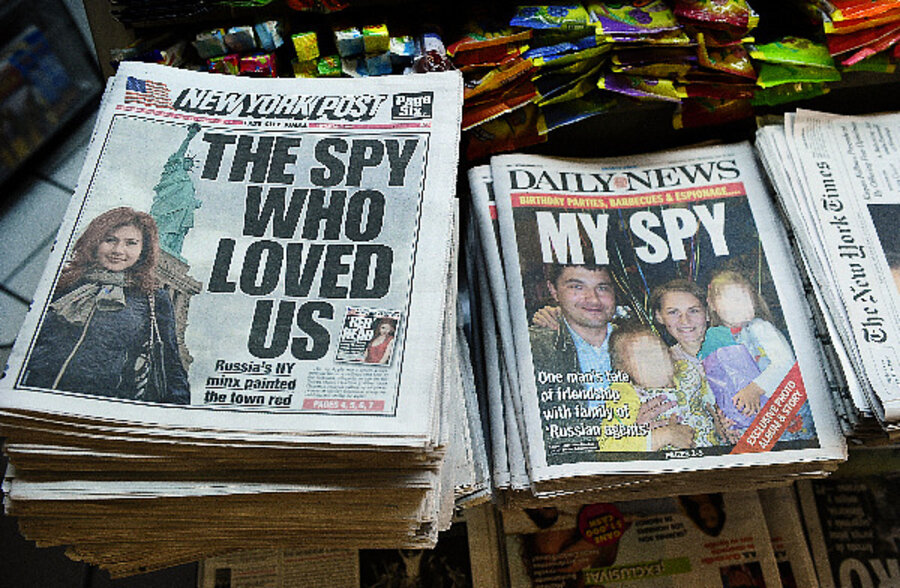Russian spies: Three remaining mysteries
Loading...
| Washington
The world has learned a lot about the Russian spy suspects in the US in recent days.
Sultry Anna Chapman has broken hearts on two continents, for instance; her father may have been a top official in the old KGB. Juan Jose Lazaro Sr. has vowed greater loyalty to Russian intelligence than to his son, say prosecutors – who add they don’t know Mr. Lazaro’s real name. A woman whose Virginia neighbors knew her as “Patricia Mills” has told court officials her real name is Natalia Pereverzeva. And so on.
Meanwhile, legal cases against the suspects have begun to lurch forward.
IN PICTURES: Top notorious spies
Most of the accused in custody have appeared in open court at bail hearings in New York, Massachusetts, or Virginia. Their indictments don’t mention espionage charges, but that does not mean they could get off lightly. Experts note they still face tough federal charges, particularly those charged with money laundering, which can result in lengthy prison terms under sentencing guidelines.
“They do face significant time,” says Stan Twardy, a former US attorney for Connecticut who is now a partner at Day Pitney LLP in Stamford. And the government likely has a good case.
Hundreds of hours of video and audio surveillance over a decade have produced vast amounts of evidence against the suspects, eight of whom are husband-and-wife teams who allegedly were sent to the US to live as Americans and gradually develop ties to policymakers and other important people.
But for all that has been made public about the sweeping Russian spy scandal of 2010, tantalizing mysteries remain – some of which may not be answered until US and Russian archives about the case are opened decades in the future. Among them:
What alerted the FBI to these suspects in the first place? In charging documents about the cases released so far, there is lots of detail of alleged activities – cash buried in upstate New York, and uncovered two years later; secret messages inscribed in photos on public websites, etc. But there is no mention of founding incidents – whatever it was that brought these people to the attention of the US government.
This is a particularly interesting omission in light of the fact that the suspects did not appear to know about one another. The husband-and-wife teams knew of their partners, of course, but beyond that this was clearly not a spy “ring,” as it has sometimes been described. It was a collection of disparate efforts.
That means it is unlikely that the US found out about them all by stumbling upon one, who then betrayed the rest. Are the charges just the result of years of electronic surveillance? Did a higher-level turncoat hand information about them to the FBI? Does the US have a mole inside Russia’s foreign intelligence service, the SVR?
“That’s the biggest mystery here – how did the government get on to these people?” says Stephen Vladeck, a professor and expert in national security law at American University’s Washington College of Law.
How far along were the suspects in their (alleged) spy careers? Much has been made of the fact that none of those arrested has been charged with actual espionage. There is no mention in court papers of passed secrets, or even of much association with any sources who would know any sensitive US information at all. From this, many experts have deduced the alleged spy effort a waste of time and money by the Russians, or an example of incompetence on the part of the suspects themselves.
But how do we know what they were supposed to be producing, and when? We don’t, not really, points out Mr. Vladeck of American University.
“My suspicion is that part of the reason there is no espionage charge is that they did not commit any espionage,” he says.
It is possible that the suspects were sleeper agents in the sense that they were to position themselves in US society and wait decades, slowly rising in their professions, before beginning to produce useful intelligence. It is possible that they were a hedge, sent to the US just in case US-Russia relations turned for the worse in the future.
It is also possible that they were crummy spies and a drain on Russian taxpayers.
Why did the US arrest them? The US rounded up all the suspects at once, with the exception of one, Christopher Metsos. (Mr. Metsos was subsequently arrested in Cyprus, then granted bail. Predictably, he hung a “Do Not Disturb” sign on his hotel room door and fled to parts unknown.)
Prosecutors said they carried out the mass arrests because one of the suspects was set to leave the country and they did not want to lose cases they had worked on for years.
But over the past 10 years many of the suspects traveled abroad at some point. And if most of the suspects did not know most of the others, why would they have fled if one was arrested? Presumably, they might have become nervous if the news became public, but they would not necessarily have thought they themselves were next.
But what if the exposure of the spy suspect was due to a higher-level leak? (See Mystery No. 1, above.) In that case, the SVR might have known exactly how many of its people risked exposure, and alerted them to the danger.
IN PICTURES: Top notorious spies
Related:
The cold war is over, so why the fascination with Russian spies?
Russian spies: Top 5 old-school espionage technologies that still work





